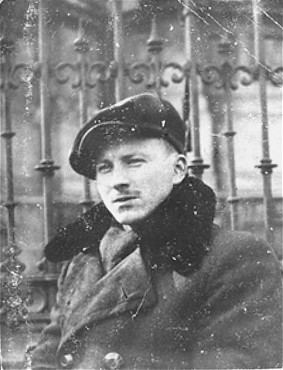Children 2 Name Benjamin Meed | ||
 | ||
Full Name Benyomin Miedzyrzecki Died October 24, 2006, New York City, New York, United States | ||
Jewish survivor benjamin meed testimony part 1
Benjamin Meed (born Benyomin Miedzyrzecki, February 19, 1918 – October 24, 2006), a Polish Jew, fought in the Warsaw ghetto underground, served on the Advisory Board of the President's Commission on the Holocaust, planned the 1981 World Gathering of Jewish Holocaust Survivors and the 1983 American Gathering of Jewish Holocaust Survivors held in Washington, D.C. and other reunions that followed, and was President of the American Gathering of Jewish Holocaust Survivors and their Descendants.
Contents
Early life
Meed was born in Warsaw, Poland. He had three siblings.
Career
Meed was in a business high school when World War II erupted. Within a short time he was living in the Warsaw ghetto and working as a slave laborer. Recruited into the underground by his future wife Vladka Meed (née Fayge Peltel), whom he met in the midst of the war, he was responsible for rescuing ghetto fighters and finding and building hiding places for them. Using their assumed names Czeslaw Pankiewicz (Ben) and Bronislawa "Vladka" Wa(n)chalska (Fayge), they were among those Jews on the "Aryan" side of the ghetto wall who distributed the April 23, 1943, appeal from the Jewish Fighting Organization.
The Meeds helped plan the 1981 World Gathering of Jewish Holocaust Survivors held in Israel, the first event of its kind. That same year, the organizers established the American Gathering of Jewish Holocaust Survivors to prepare for a 1983 gathering in Washington, D.C., which attracted 20,000 survivors and their families. Meed was able to convince the Capital Centre to waive the fees for use of the facilities, but they were told that the payments to the union employees who work the venue would not be included in the waiver. After the event, the union employees, after witnessing the connections of survivors at the event, said that they also waived the charge for their services.
Soon after its founding, the American Gathering established a Registry of Jewish Holocaust Survivors, the a database of survivors and their families. The Benjamin and Vladka Meed Registry of Jewish Holocaust Survivors is housed at the Museum and has become an important tool for families and researchers.
He was also deeply committed to teacher training, as he and Mrs. Meed, through the American Gathering and the Jewish Labor Committee, created the "Summer Seminar Program on Holocaust and Jewish Resistance."
Mr. Meed served on the Advisory Board of the President's Commission on the Holocaust, which recommended the United States Holocaust Memorial Museum's establishment. He also served on the United States Holocaust Memorial Council, the Museum's governing body, from 1980 to 2004, where he chaired several crucial committees: the Days of Remembrance Committee and the Museum Content Committee, which oversaw the creation of the Museum's Permanent Exhibition. He was responsible for institutionalizing Holocaust commemorations in the nation's capital, at state houses and cities across the country, and at military installations worldwide.
In November 2003, in honor of the Museum's 10th anniversary, Mr. Meed conceived "A Tribute to Holocaust Survivors: A Reunion of a Special Family," which honored survivors, liberators and rescuers as well as their families. More than 7,000 people, four generations strong, traveled to Washington from 38 states and around the world to take part in the largest Museum event since its opening.
Mr. Meed served as president of the American Gathering from its inception until his death.
Personal life
The couple married shortly after the war, and in May 1946 they immigrated on the second boat, the Marine Flasher, that carried survivors to the United States. Meed worked in the import-export business. They had two children, Steven and Anna, both of whom became physicians.
